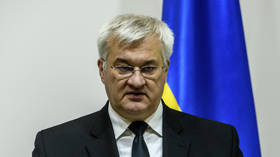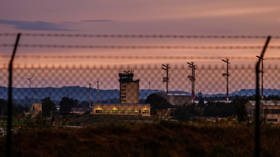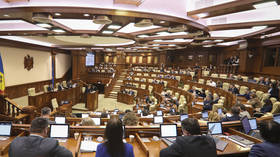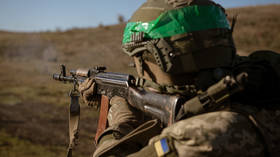New York Times takes anti-Russian hysteria to new level with report on Russian ‘bounty’ for US troops in Afghanistan
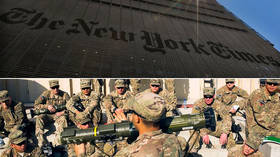
The New York Times published an article claiming that Russia was paying out monetary bounties to the Taliban to kill US troops in Afghanistan. There’s just one problem — none of what they reported was true.
As news reporting goes, the New York Times article alleging that a top-secret unit within Russian military intelligence, or GRU, had offered a bounty to the Taliban for every US soldier killed in Afghanistan, was dynamite. The story was quickly “confirmed” by the Washington Post, the Wall Street Journal and other newspapers, and went on to take social media by storm. Twitter was on fire with angry pundits, former officials, and anti-Trump politicians (and their respective armies of followers) denouncing President Trump as a “traitor” and demanding immediate action against Russia.
There was just one problem — nothing in the New York Times could be corroborated. Indeed, there is no difference between the original reporting conducted by the New York Times, and the “confirming” reports published by the Washington Post and the Wall Street Journal. All of the reports contain caveats such as “if confirmed” and “if true,” while providing no analysis into the potential veracity of the information used to sustain the report — alleged debriefs of Afghan criminals and militants — or the underpinning logic, or lack thereof, of the information itself.
For its part, the Russian government has vociferously denied the allegations, noting that the report “clearly demonstrates low intellectual abilities of US intelligence propagandists who have to invent such nonsense instead of devising something more credible.” The Taliban have likewise denied receiving any bounties from the Russians for targeting American soldiers, noting that with the current peace deal, “their lives are secure and we don’t attack them.”
Also on rt.com ‘Phony hit job’ by ‘fake news’ NYT, says Trump on claims of ‘so-called attacks on our troops in Afghanistan by Russians’Even more telling is the fact that the current Director of National Intelligence John Ratcliffe has come out to contradict a key element of the New York Times’ report—that the president was briefed on the intelligence in question. “I have confirmed that neither the president nor the vice president were ever briefed on any intelligence alleged by the New York Times in its reporting yesterday,” Ratcliffe said in a statement. “The New York Times reporting, and all other subsequent news reports about such an alleged briefing are inaccurate.”
And one more tiny problem: Trump confirmed there was no such briefing, too.
Perhaps the biggest clue concerning the fragility of the New York Times’ report is contained in the one sentence it provides about sourcing — “The intelligence assessment is said to be based at least in part on interrogations of captured Afghan militants and criminals.” That sentence contains almost everything one needs to know about the intelligence in question, including the fact that the source of the information is most likely the Afghan government as reported through CIA channels.
There was a time when the US military handled the bulk of detainee debriefings in Afghanistan. This changed in 2014, with the signing of the Bilateral Security Agreement. This agreement prohibits the US military from arresting or detaining Afghans, or to operate detention facilities in Afghanistan. As a result, the ability of the US military to interface with detainees has been virtually eliminated, making the Pentagon an unlikely source of the information used by the New York Times in its reporting.
The CIA, however, was not covered by this agreement. Indeed, the CIA, through its extensive relationship with the National Directorate of Security (NDS), is uniquely positioned to interface with the NDS through every phase of detainee operations, from initial capture to systemic debriefing.
Also on rt.com Trump & Pence never briefed on ‘Russian bounties for Taliban’, NYT story ‘inaccurate’ – US intelligence chiefLike any bureaucracy, the CIA is a creature of habit. Henry ‘Hank’ Crumpton, who in the aftermath of 9/11 headed up the CIA’s operations in Afghanistan, wrote that
“[t]he Directorate of Operations (DO) should not be in the business of running prisons or temporary detention facilities. The DO should focus on its core mission: clandestine intelligence operations. Accordingly, the DO should continue to hunt, capture, and render targets, and then exploit them for intelligence and ops leads once in custody. The management of their incarceration and interrogation, however, should be conducted by appropriately experienced US law enforcement officers because that is their charter and they have the training and experience.”
After 2014, the term “US law enforcement officers” is effectively replaced by “Afghan intelligence officers”— the NDS. But the CIA mission remained the same — to exploit captives for intelligence and operational leads.
The Trump administration has lobbied for an expanded mission for the CIA-backed NDS and other militia forces to serve as a counterterrorism force that would keep Islamic State (IS, formerly ISIS) and Al-Qaeda from gaining a foothold in Afghanistan once US and foreign troops completed their planned withdrawal in 2021. But the CIA has raised objections to such a plan, noting that the NDS and other CIA-controlled assets were completely dependent upon US military air power and other combat service support resources, and that any attempt to expand the CIA’s covert army in Afghanistan following a US military withdrawal would end in disaster. Having the NDS fabricate or exaggerate detainee reports to keep the US engaged in Afghanistan is not beyond the pale.
Also on rt.com Caitlin Johnstone: It is the US intelligence’s job to lie to you. NYT’s Afghan bounty story is CIA press release disguised as newsWhich brings up the issue of Russian involvement. In September 2015, the Taliban captured the northern Afghan city of Konduz, and held it for 15 days. This sent a shockwave throughout Russia, prompting Moscow to reconsider its approach toward dealing with the Afghan insurgency. Russia began reaching out to the Taliban, engaging in talks designed to bring the conflict in Afghanistan to an end. Russia was driven by other interests as well. According to Zamir Kabulov, President Vladimir Putin's special representative for Afghanistan, “the Taliban interest objectively coincides with ours” in the fight against Islamic State, which in the summer of 2014 had captured huge tracts of land in Syria and Iraq, including the city of Mosul, Iraq’s second largest.
By 2017, Afghan and US intelligence services had assembled a narrative of Russian assistance to the Taliban which included the provision of advanced weaponry, training, and financial support. While Russia denied providing any direct military support to the Taliban, it maintained that the Taliban were the best way to deal with the growing threat of Islamic State. But even if the US reports were correct, and Russia was angling for a Taliban victory in Afghanistan, the last policy Russia would logically pursue would be one that had the US remain in Afghanistan, especially after pushing so hard for a negotiated peace. Russia’s interests in Afghanistan were — and are — best served by Afghan stability, the antithesis of the Afghan reality while the US and NATO remain engaged. Getting the US out of Afghanistan — not keeping the US in Afghanistan — is the Russian position, and any CIA officer worth his or her salt knows this.
It does not take a rocket scientist to read between the lines of the New York Times’ thinly sourced report. The NDS, with or without CIA knowledge or consent, generated detainee-based intelligence reports designed to create and sustain a narrative that would be supportive of US military forces remaining in Afghanistan past 2021. The CIA case officer(s) handling these reports dutifully submit cables back to CIA Headquarters which provide the gist of the allegations — that Russia has placed a bounty on US soldiers. But there is no corroboration, nothing that would allow this raw “intelligence” to be turned into a product worthy of the name.
Also on rt.com There they go again: NYT serves up spy fantasy about Russian ‘bounties’ on US troops in AfghanistanThis doesn’t mean that someone in the bowels of the CIA with an axe to grind against Trump’s plans to withdraw from Afghanistan, or who was opposed to Trump’s efforts to normalize relations with Russia, didn’t try to breathe life into these detainee reports. Indeed, a finished “product” may have made its way to the National Security Council staff — and elsewhere — where it would have been given the treatment it deserved, quickly discarded as unsubstantiated rumor unworthy of presidential attention.
At this point in time, frustrated by the inattention the “system” gave to the “intelligence,” some anonymous official contacted the New York Times and leaked the information, spinning it in as nefarious a way as possible. The New York Times blended the detainee reports and its own previous reporting on the GRU to produce a completely fabricated tale of Russian malfeasance designed to denigrate President Trump in the midst of a hotly contested reelection bid.
Too far-fetched? This assessment is far more fleshed out with fact and logic than anything the New York Times or its mainstream media mimics have proffered. And lest one thinks the GrayLady is above manufacturing news to sustain support for a war, the name Judith Miller, and the topic of Iraqi weapons of mass destruction, should put that to rest. The reporting by the New York Times alleging the existence of a Russian bounty on the lives of US troops in Afghanistan is cut from the same piece of cloth as its pre-war Iraq drivel. As was the case with Iraq, the chattering class is pushing these new lies on an American audience pre-programmed to accept at face value any negative reporting on Russia. This is the state of what passes for journalism in America today, and it’s not a pretty sight.
Think your friends would be interested? Share this story!
The statements, views and opinions expressed in this column are solely those of the author and do not necessarily represent those of RT.






